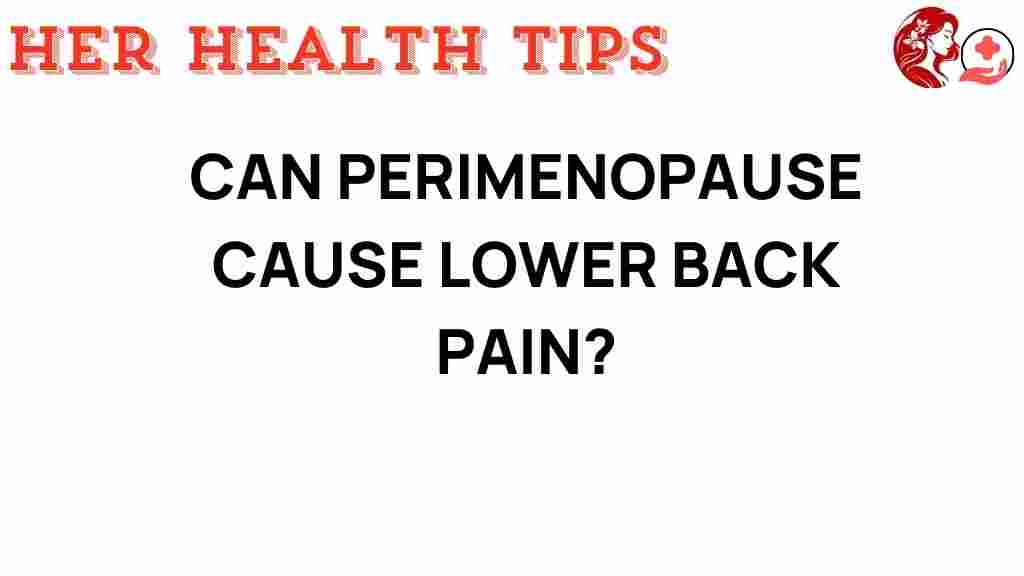Unraveling the Mystery: Can Perimenopause Trigger Lower Back Pain?
As women transition through various stages of life, they often encounter a range of physical and emotional changes. One of the significant phases is perimenopause, which can lead to various symptoms, including lower back pain. Understanding the connection between hormonal changes during this time and the onset of pain is crucial for women’s health.
Understanding Perimenopause
Perimenopause is the transitional phase leading up to menopause, typically occurring in women in their 40s, although it can start earlier for some. During this period, the body undergoes various hormonal changes as estrogen and progesterone levels fluctuate. These changes can impact many aspects of health, including muscle and joint function, which may contribute to lower back pain.
Hormonal Changes and Their Effects
The hormonal shifts during perimenopause can result in numerous symptoms, including:
- Hot flashes
- Night sweats
- Mood swings
- Irregular periods
- Lower back pain
Estrogen plays a vital role in maintaining bone density and muscle strength. As levels decline, women may experience:
- Increased stiffness in joints
- Weakened muscles
- Heightened sensitivity to pain
These factors can lead to an increased risk of developing chronic pain, particularly in the lower back.
Link Between Perimenopause and Lower Back Pain
Many women report experiencing lower back pain during perimenopause, which can be attributed to several factors:
- Muscle Weakness: As estrogen levels drop, muscle strength may decline, making the back more susceptible to strain and injury.
- Joint Changes: The hormonal changes can lead to joint stiffness and inflammation, which can exacerbate lower back pain.
- Posture Issues: Hormonal fluctuations can lead to mood changes, causing some women to adopt poor posture, contributing to back pain.
- Weight Gain: Many women experience weight gain during perimenopause, which can put additional strain on the back.
Pain Management Strategies
Managing lower back pain during perimenopause requires a multifaceted approach. Here are some effective strategies:
Exercise and Physical Activity
Regular exercise can significantly improve muscle strength and flexibility, reducing the risk of lower back pain. Consider the following types of exercise:
- Strength Training: Focus on core strengthening exercises to support the back.
- Yoga: This promotes flexibility and can help alleviate tightness in the lower back.
- Aerobic Activities: Walking, swimming, or cycling can enhance overall health and manage weight.
Maintain a Healthy Weight
Weight management is crucial as excess weight can increase pressure on the spine. A balanced diet rich in fruits, vegetables, whole grains, and lean proteins can aid in maintaining a healthy weight.
Physical Therapy
If lower back pain becomes chronic, consulting a physical therapist can provide personalized exercises and treatment plans tailored to your needs.
Pain Relief Medications
Over-the-counter pain relief medications, such as ibuprofen or acetaminophen, can be effective for managing pain. However, consultation with a healthcare provider is essential before starting any medication.
Alternative Therapies
Many women find relief through alternative therapies, including:
- Acupuncture: This traditional Chinese medicine practice may relieve pain and improve overall well-being.
- Chiropractic Care: Regular adjustments can help realign the spine and alleviate pain.
- Massage Therapy: This can reduce muscle tension and promote relaxation.
Stress Management
Since stress can exacerbate pain, incorporating stress management techniques such as meditation, deep breathing exercises, or mindfulness can be beneficial.
Health Awareness and Communication
Understanding the relationship between perimenopause and lower back pain is vital for health awareness. Women should feel empowered to communicate with their healthcare providers about their symptoms. Regular check-ups can help monitor health changes and address concerns related to menopause symptoms.
When to Seek Medical Attention
While occasional back pain is common, certain symptoms warrant medical attention:
- Severe pain that interferes with daily activities
- Pain accompanied by numbness or tingling
- Sudden weight loss
- Fever or unexplained symptoms
Consulting a healthcare provider for persistent or severe symptoms is crucial for proper diagnosis and treatment.
Conclusion
In conclusion, understanding how perimenopause can trigger lower back pain is essential for managing symptoms effectively. The hormonal changes during this transitional phase can lead to various physical challenges, including increased pain sensitivity and muscle weakness. By adopting pain management strategies, maintaining a healthy lifestyle, and staying informed about women’s health, women can navigate this period with more confidence and comfort.
For more information on menopause symptoms and managing chronic pain during this phase, check out this comprehensive guide. Staying proactive about health and wellness can make a significant difference in overall quality of life.
If you or someone you know is struggling with symptoms of perimenopause or lower back pain, don’t hesitate to reach out to a healthcare professional for support and guidance. Awareness and action can empower women to manage their health effectively during this significant life transition.
This article is in the category Conditions and created by HerHealthTips Team
